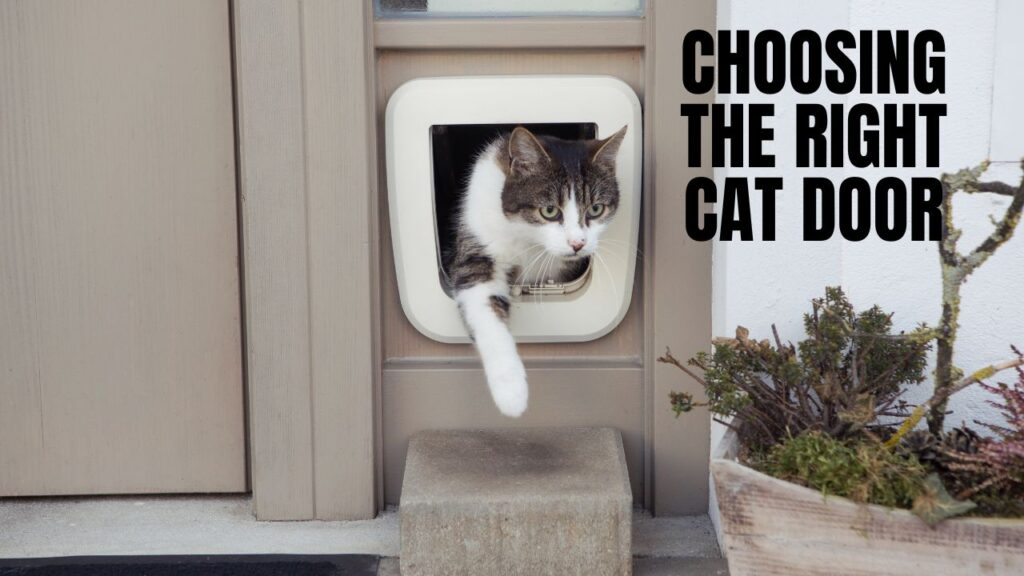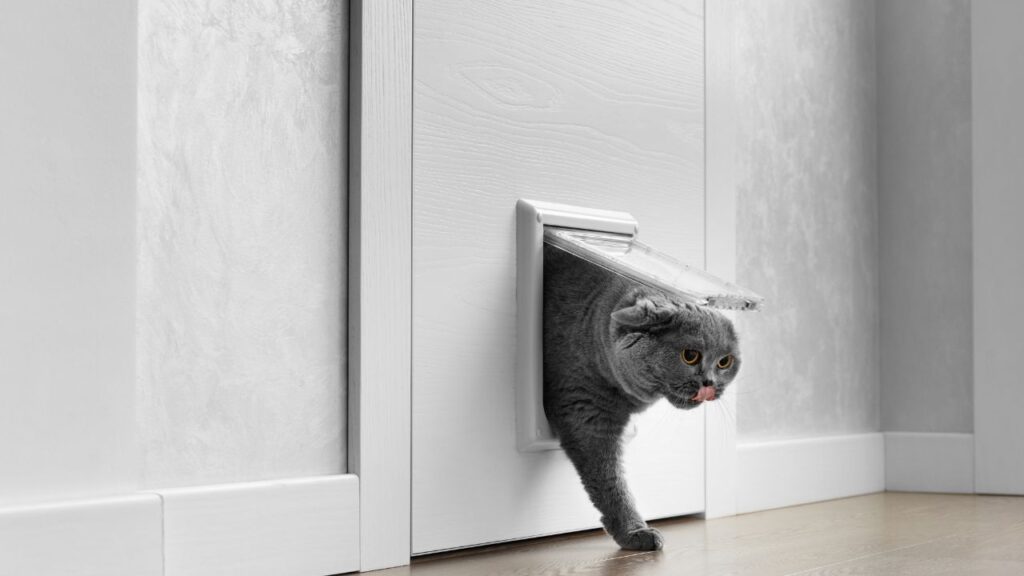Have you ever found yourself standing at the door, keys in hand, balancing groceries or laundry, while your cat stares at you expectantly, ready to go out—or come back in? We’ve all been there, right? It’s one of those “little problems” that can really add up, especially when you have a cat who loves to be outside. But what if you could train your cat to use a cat door, so they could come and go as they please without needing you to act as a doorman every time?
Sounds too good to be true? Well, with the right approach, it’s absolutely possible. In this guide, we’re going to walk you through how to train a cat to use a cat door, step-by-step. From choosing the right door to training techniques and troubleshooting tips, you’ll have all the information you need to make your cat door experience as smooth as possible.
Contents
Why Should You Train Your Cat to Use a Cat Door?
Before we jump into the nitty-gritty of training, let’s talk about why this is even a good idea in the first place. Why should you go through the effort of training your cat to use a cat door when you can just open the door for them?
1. Independence for Your Cat
Imagine how freeing it must feel for your cat to wander in and out without waiting for you. It’s a confidence booster for them, and let’s face it—cats love to have control over their surroundings. If they can come and go as they please, they’re happier, more content, and less reliant on you for every little thing.
2. Convenience for You
As much as we love our furry friends, constantly opening the door for them can get old. Whether you’re in the middle of work, cleaning, or just chilling on the couch, having to drop everything for a cat who wants out can be a real drag. A cat door removes this hassle and makes life a lot easier for you. Plus, if you have a busy schedule or work from home, it gives your cat the autonomy to go outside when you’re not around.
3. Encouraging Exercise and Mental Stimulation
If you’ve got a curious cat who loves to explore, a cat door allows them to roam freely. Whether it’s for a quick garden patrol or a longer adventure, they get the exercise and stimulation they need, which can help reduce boredom and anxiety.

Step 1: Choosing the Right Cat Door
Before you start training, you need to have the right equipment in place. A cat door is a simple enough tool, but not all cat doors are made equal. Here’s what to consider when picking one:
1. Size of the Door
Make sure the door is large enough for your cat to pass through easily. Measure your cat’s size, from their height and width to their weight, and choose a door that’s big enough but not too large. The last thing you want is for your cat to feel like they’re going through a cave.
2. Style of the Door
There are several types of cat doors to choose from:
- Flap doors: The classic flap that swings open when the cat pushes it. They’re the easiest to use and are great for indoor/outdoor access.
- Magnetic doors: These doors use a magnet to keep the flap closed, which means fewer drafts and less noise. A great option for those living in cooler climates.
- Electronic doors: These doors only open when your cat (or the microchip in their collar) is nearby. While this type is more expensive, it’s a good choice if you want to keep out other animals.
3. Material and Durability
Choose a sturdy door, particularly if you’re placing it in a high-traffic area or your cat is particularly strong. A flimsy door won’t last long, and cats can be surprisingly persistent when it comes to scratching or pushing open doors that aren’t up to the task.
Step 2: Preparing Your Cat for the Training Process
Okay, you’ve got your cat door set up and ready to go. Now, it’s time to get your cat on board with the idea. Not all cats will immediately take to a cat door, so be prepared for a little patience and persistence.
1. Familiarize Your Cat with the Door
Start by introducing your cat to the door when it’s stationary. You can do this by:
- Letting them explore: Gently open the door and let them sniff around it. Cats are naturally curious, so they’ll likely take to investigating the new “thing” in their environment.
- Use treats or toys: Encourage your cat to interact with the door by placing treats near it or even under it. You can also use their favorite toy to get them to play with the door—this builds positive associations.
- Leave the door propped open: For the first few days, leave the door open so your cat can get used to the sight and smell of it without feeling confined.
2. Create Positive Associations
Cats are more likely to use the cat door if they associate it with positive experiences. Here’s how:
- Feed near the door: Place your cat’s food dish near the door to get them used to being around it. Eventually, move it closer to the door opening.
- Reward progress: Every time your cat interacts with the door—whether it’s sniffing it, rubbing it, or stepping through it—reward them with treats, praise, or affection. The more you reinforce the behavior, the quicker they’ll adapt.
Step 3: Training Your Cat to Use the Cat Door
Now comes the exciting part: teaching your cat how to actually use the cat door.
1. Start with a Low Barrier
If the door is a flap, start by gently holding the flap open so your cat can walk through. This will help them get used to the motion of the door and the idea that it’s not something to be scared of.
- You can also help them by gently guiding them through the door at first, using treats or a favorite toy to encourage them.
2. Use Positive Reinforcement
As soon as your cat steps through the door, give them a treat and praise them. Positive reinforcement is key to encouraging the behavior you want to see more of. If they’re hesitant or unsure, don’t force them—just let them take their time.
3. Gradually Close the Door
Once your cat is comfortable going through with the door open, you can start gradually closing it. At first, just close it slightly, and then open it again once they walk through. Over time, increase the closure until your cat can walk through a fully closed door without hesitation.
4. Practice Both Ways
Make sure your cat is comfortable going through the door both ways. Whether they need to go out or come in, they should be able to walk through with ease. You can use treats, toys, or verbal praise to encourage them to go through in both directions.

Step 4: Troubleshooting Common Problems
Like any training process, you might encounter a few roadblocks along the way. Here are some common issues and how to handle them:
1. Fear of the Door
If your cat is frightened by the sound of the door or the flap, you can help desensitize them by:
- Slowly introducing the sound: Gently tap the flap and reward your cat for investigating. Gradually increase the noise, so they get used to it without feeling overwhelmed.
- Using a less intrusive door: If the sound is too much, you might want to consider a magnetic door or an electronic one that opens automatically, as these tend to be quieter.
2. Not Going Through the Door
If your cat isn’t using the door as expected, don’t give up. You may need to take a few steps back and go slower. Perhaps your cat is still adjusting to the new space, or they might need more time with positive reinforcement before they’re fully comfortable.
3. Confusion or Frustration
If your cat starts scratching or pawing at the door aggressively, it could be a sign of frustration. Don’t force them to use the door, and instead, go back to the familiarization phase, offering treats and rewards until they’re more comfortable with the door.
Final Thoughts: Patience is Key
Teaching your cat how to use a cat door can take time, but with the right approach, patience, and rewards, your cat will soon be mastering it. Just remember, every cat is different, and some will catch on faster than others. The most important thing is to make the process enjoyable for both you and your cat.
Once your cat is happily using their new door, you’ll enjoy the convenience and your cat will enjoy their newfound independence. So, give it a try—and remember, a little encouragement can go a long way!
Key Takeaways
- Choose the right cat door that suits your home and your cat’s needs.
- Start by familiarizing your cat with the door using treats and toys.
- Use positive reinforcement and gradual steps to teach your cat how to use the door.
- Be patient, and don’t give up if your cat takes some time to adjust!
Happy training, and enjoy your newfound freedom (for both you and your cat)!

